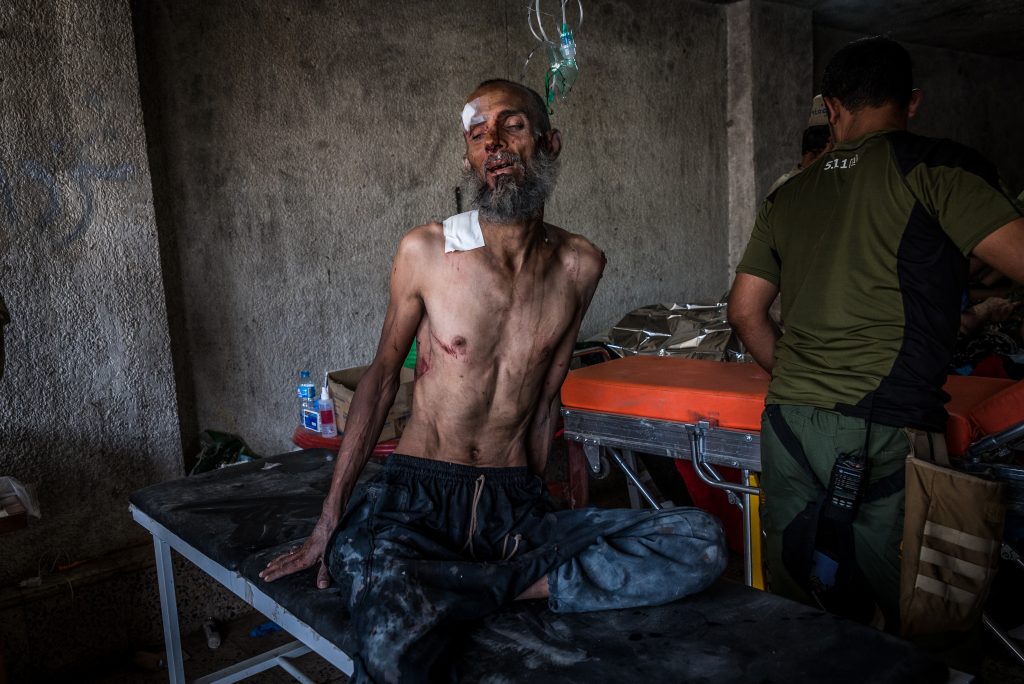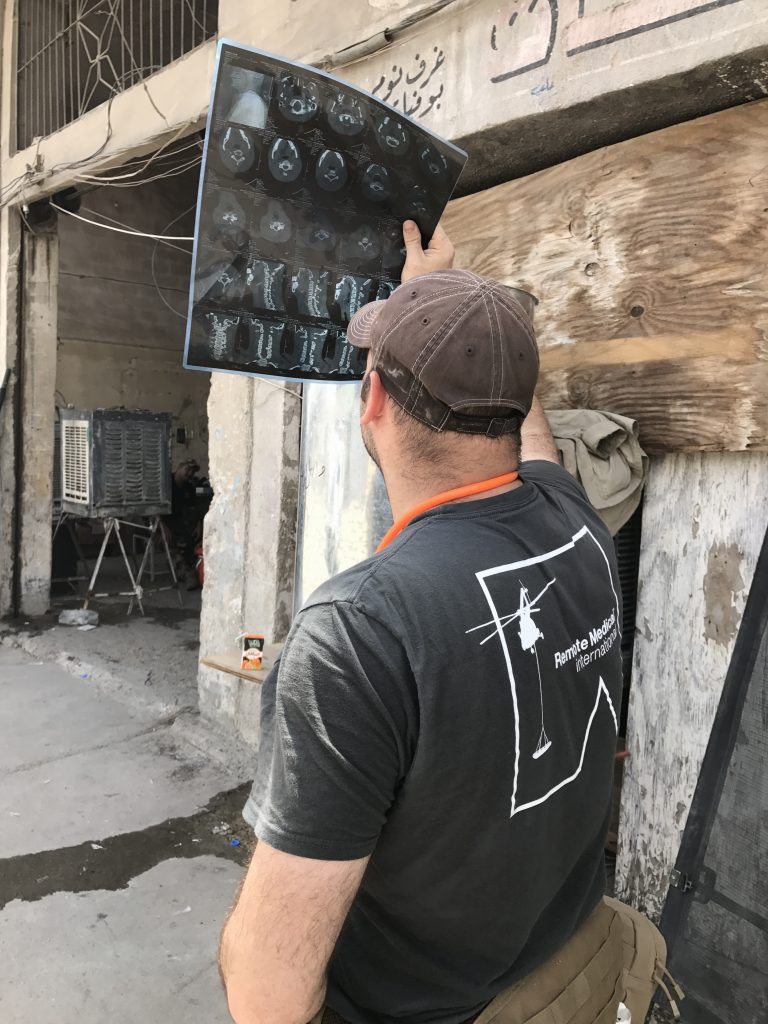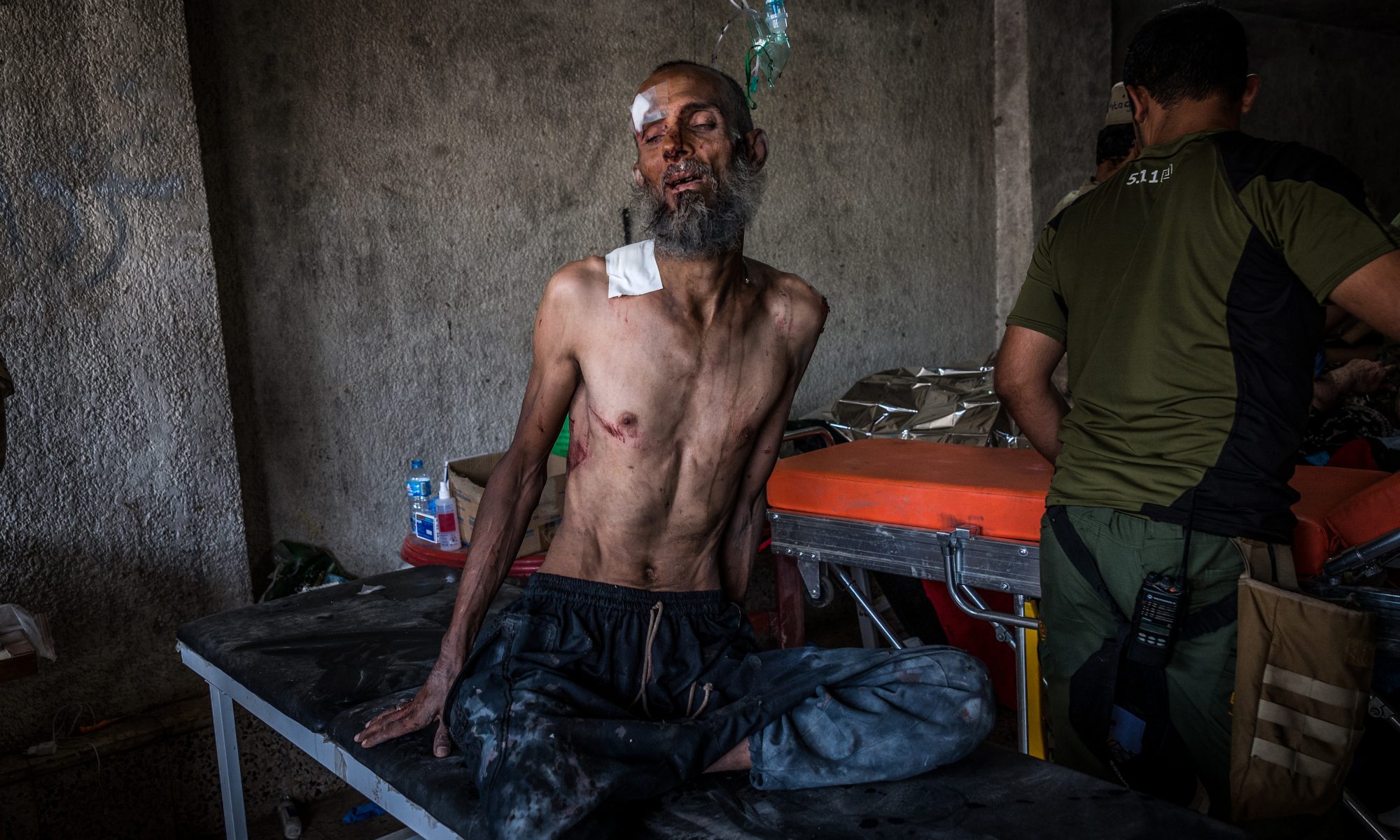Baby with massive head injury, I pronounced [dead] in front of mom, she was crying, I almost did but it was in the middle of an MCI, I wrapped the child in a space blanket and went to attend to another kid.
Glossary:
ISOF: Iraqi Special Operations Forces
TSP: Trauma Stabilization Point
MSF: Doctors without Borders
VBIED: Vehicle Borne IED
Daesh: Arabic name for IS/ISIS/ISIL, possibly derogatory, largely interchangeable with IS/ISIS/ISIL. There’s more to it than that, but can we just generally agree, fuck those guys?
Blast patient, left leg partial amp [amputation], right leg massive injuries, right arm same as right leg, three tourniquets applied, I decompressed twice between the TSP and transport, coalition hospital did bilateral decompression, open heart massage and finger thorocostomy, patient expired.
This patient had massive injuries and there’s no question in my mind that without the TSP being so far forward he wouldn’t have survived as long as he did. If we had blood products perhaps there would have been a different outcome but based on the physician’s assessment at the coalition hospital survival was still unlikely. After the resuscitation concluded the physician felt some structures inside the patient’s chest and abdomen and was able to tell that the diaphragm had ruptured plus there was a significant amount of free blood in the abdomen. In addition to the injuries we saw the patient had devastating internal injuries.
When most people refer to “the coalition” in regards to Mosul or the fight against Daesh in general they word that follows is often “airstrike”. What is much less commonly talked about are the incredible healthcare providers from the US, Canada, New Zealand, Australia, the UK, and possibly other countries (most didn’t wear uniforms so nationality wasn’t clear) who deployed to treat some of the casualties. The “coalition hospital” was a bit closer, at least on the outside, to the facilities seen in MASH than a modern hospital.
After driving through several check points, around multiple concrete barricades, past a helicopter landing zone, the ambulance pulls up to an open gravel area ringed by concrete blast shields. Typically before I could open the back doors they were opened by a cheery Kiwi in a t-shirt, silkies, desert boots, and a ball cap, wearing a side arm who eagerly received my patient. He was always a welcomed face, especially when my patient’s severity was exceeding my capability. I would give him the key points about my patient and we would start moving towards to the hospital, walking past further blast shields and in to a tent like structure lined with plastic staffed by a multinational team of special forces medics, physicians, nurses, and technicians.
Each patient bed had a cardiac monitor hung above the head and trauma supplies carefully stacked behind the head waiting for the next casualty to arrive.
This particular day I saw a few familiar faces, providers who I had brought multiple patients over the last few days, one of whom greeted me by name and said “What have you got?” I gave a quick sentence with the major injuries and our interventions. As I was doing this the patient was being moved off of my stretcher to one of their beds and the physician was beginning his assessment while calling out for procedure trays.
Being in the coalition hospital was always a relief. They had air conditioning which was uncommon but more than that they had enough people, enough resources, and little things like adequate lighting. I pride myself on being independent and self-sufficient, but when a patient is going south fast it is great to turn that patient over to some folks smarter than me.
On a somewhat funny note, the Kiwi, confused me a bit when one day when as I’m bringing the patient out of the ambulance he firmly, but casually stated “the grenades can’t come in to the hospital.”
I looked at my patient who I had cut most of the clothes off of and tried to figure out how the hell I missed not one, but multiple grenades. At that moment I realized he was talking about a second patient who had been loaded in to the passenger seat of the ambulance, unbeknownst to me, and was starting to walk towards the hospital wearing a belt with four or more grenades clearly visible.
More holocaust civilians
I still haven’t found a better way to describe these civilians than drawing parallels to those liberated from concentration camps.

When viewing the crowds of civilians walking towards the TSP it often looked like a colorized scene from those liberated concentration camps. They were gaunt, dusty, and often being assisted by those around them.
At this point in the offensive Daesh was reportedly charging several hundred US dollars for a single 500mL water bottle and similar or higher prices for bread.
Most of the civilians I treated hadn’t eaten in days, some in more than a week or two. Many of the parents with children had fed their children the little food they were able to obtain. Even those who had been able to eat periodically were still in a massive caloric deficit. With the average temperature over 100F dehydration was easy even when water was readily available let alone being charged unreasonable sums for it.
Child came in from an ISIS hospital with a chest tube.
As I discussed previously, Daesh had some level of healthcare being provided under their regime. Despite knowing this seeing a patient arrive with a chest tube was unexpected. I had little to do with this patient so my memory of them is poor.
Quadriplegic patient with bullet lodged in spine, urinary catheter, likely septic.
Another patient that had been treated by Daesh before coming to us. This particular patient was confirmed to be a Daesh fighter. He came in with his father who was his primary care taker. The picture below shows me looking at the CT scan of this patient that was brought with him. The bullet lodged in his neck was very clearly evident making the concerns that the patient was malingering a bit irrelevant.
Treating this patient was a little challenging. Some of the Iraqis would prefer that any member of Daesh not receive care. We didn’t operate under the same principal and believed that everyone deserved the same level of care and should be treated humanely.
We believed that given the presence of a weeks old urinary catheter and the patient presenting with mild confusion and severe hypotension that he was likely septic. Our plan was to provide fluids, IV antibiotics, and get him to a hospital as soon as we could.
That plan was challenged repeatedly and the idea of transporting him vehemently opposed to the point where we received a direct order that he was not to be transported. We worked within our constraints and provided fluids and IV antibiotics but were not permitted to send him to a hospital. I believe he was eventually taken away, with his father, by Iraqi security forces.

Baby with massive head injury, I pronounced [dead] in front of mom, she was crying, I almost did but it was in the middle of an MCI, I wrapped the child in a space blanket and went to attend to another kid. The next kid was more minor.
I think the cause of this mass casualty incident was an airstrike but I don’t remember for sure. What I know is that without warning, a humvee pulled up and suddenly there was yelling in Arabic and several soldiers carrying children and assisting adults in to the TSP.
Given the speed at which patients were brought in we didn’t have time to triage and place them as we normally would. This sometimes happened when the Iraqis flooded the TSP with patients. Not a big deal, we got good at dealing with this situations. Providers would move to the most obviously severe patient and do a quick assessment to triage them. In some cases the provider would continue care on that patient and in others they would move on. Some times patients would have to wait to be seen. We did our best to get to everyone quickly but when there are 8 providers and 25 patients not everyone gets treated immediately. We tried to do the most good for the most patients.
In the case of the child I pronounced dead they were the first patient I saw but there were multiple children plus the mother that I needed to evaluate. The pain felt by parents when a child dies has always been harder for me to process than the suffering of the patient themselves. When a patient is in pain I can provide medication or at least comfort them but those parents are inconsolable.
We resolved the MCI in 15 or 20 minutes and began to prepare for the next wave of patients. That preparation meant cleaning stretchers, getting IV supplies ready, pre-drawing medications, and reorganizing trauma gear.
Take people under stress, fatigued, mildly dehydrated, give them a spike of adrenaline, and as they come down from that spike there are some odd moments.
Corn hole with quikclot sponges (in packages).
Corn hole is usually played with a metal or wood board and bean bags. The objective is to toss the bean bags through the holes to score points. This particular night we used a cardboard box as our target and tossed QuikClot Advanced Clotting Sponges (in package and still ready to be used on a patient) as our bean bags. Given the plastic packaging these substitutes did not have the same aerodynamic properties of a bean bag which added to the challenge for us.
Out of gloves, I cleaned and reused a pair
Not my best moment, but we were actually out of gloves at the TSP. I had a pair of durable nitrile gloves, designed to be a single use item, which I determined would be my best option to clean before we got more. While wearing the gloves I poured some hand sanitizer on them and then washed my gloved hands with soap and water at the metal spigot in front of the TSP.
I realize this seems pretty cringeworthy but my alternative was treating the next major trauma patient without gloves. Hopefully my efforts were sufficient to decrease the potential for cross contamination and adequately protected me.
You may be reading this and wondering how the hell any respectable organization or medical provider could run out of something as simple as gloves. The answer is that we saw a lot of patients, we had an atypical supply chain, and Amazon Prime didn’t work in Mosul. Or Erbil. Or Iraq. While I was there we had an adequate number of tourniquets, hemostatic gauze, chest seals, Ketamine, and a few other core items, that really make a major difference in patient outcome.
It was pretty common for NGOs to buy supplies on the local market, carry them in checked bags flying commercial aircraft, or other non-standard methods. Very little was easy in Iraq and Kurdistan which includes moving supplies in large volumes. Between graft, bureaucracy, political factions, and majorly damaged infrastructure in some areas organizations and individuals got creative.
If you are considering undertaking a similar endeavor anticipate that your normal means of resupply may comprised and you may need to adapt to meet your situation. Planning to improvise is entirely legitimate. Rather than wait until you are forced to improvise plan ahead, test your plan, and ensure that the improvisation is actually going to be effective. I believe as remote medicine advances we should be held to higher standards rather that just saying “well, I did my best”. If we believe that at some point we must improvise a tourniquet then we should plan to improvise an effective tourniquet. More about properly and improperly improvised medical supplies at another point.
